Numerical Evaluation of a Novel Vertical Drop Airflow System to Mitigate Droplet Transmission in Trains
Abstract
:1. Introduction
2. Methodology
2.1. Simulation Domain
2.2. Simulation Model
- The influence of droplets on airflow is negligible;
- Droplets are assumed to be ideally shaped spheres;
- Coagulation of droplets is negligible;
- The energy equation is negligible;
- The droplet expelled from the patient’s mouth does not evaporate.
2.2.1. Eulerian Model
2.2.2. Lagrangian Model
2.2.3. Mask Model
2.3. Boundary Conditions
2.4. Validation
3. Results and Discussion
3.1. Comparison of Conventional and VDA Systems
3.2. Effect of Wearing Masks
4. Conclusions
Author Contributions
Funding
Institutional Review Board Statement
Informed Consent Statement
Data Availability Statement
Conflicts of Interest
References
- Chi, X.; Hua, J.; Hua, S.; Ren, X.; Yang, S. Assessing the Impacts of Human Activities on Air Quality during the COVID-19 Pandemic through Case Analysis. Atmosphere 2022, 13, 181. [Google Scholar] [CrossRef]
- Deb, P.; Furceri, D.; Ostry, J.D.; Tawk, N. The economic effects of Covid-19 containment measures. Open Econ. Rev. 2021, 33, 1–32. [Google Scholar] [CrossRef]
- Otter, J.A.; Donskey, C.; Yezli, S.; Douthwaite, S.; Goldenberg, S.; Weber, D.J. Transmission of SARS and MERS coronaviruses and influenza virus in healthcare settings: The possible role of dry surface contamination. J. Hops. Infect. 2016, 92, 235–250. [Google Scholar] [CrossRef] [PubMed] [Green Version]
- Xu, X.; Zhang, J.; Zhu, L.; Huang, Q. Transmission of SARS-CoV-2 Indoor and Outdoor Environments. Atmosphere 2021, 12, 1640. [Google Scholar] [CrossRef]
- Jayaweera, M.; Perera, H.; Gunawardana, B.; Manatunge, J. Transmission of COVID-19 virus by droplets and aerosols: A critical review on the unresolved dichotomy. Environ. Res. 2020, 188, 109819. [Google Scholar] [CrossRef]
- Hang, J.; Li, Y.; Jin, R. The influence of human walking on the flow and airborne transmission in a six-bed isolation room: Tracer gas simulation. Build. Environ. 2014, 77, 119–134. [Google Scholar] [CrossRef]
- Kakimoto, K.; Kamiya, H.; Yamagishi, T.; Matsui, T.; Suzuki, M.; Wakita, T. Initial investigation of transmission of COVID-19 among crew members during quarantine of a cruise ship—Yokohama, Japan, February 2020. Morb. Mortal. Wkly. Rep. 2020, 69, 312. [Google Scholar] [CrossRef]
- Yang, N.; Shen, Y.; Shi, C.; Ma, A.H.; Zhang, X.; Jian, X.; Wang, L.; Shi, J.; Wu, C.; Li, G.; et al. In-flight transmission cluster of COVID-19: A retrospective case series. Infect. Dis. 2020, 52, 891–901. [Google Scholar] [CrossRef]
- Shen, Y.; Li, C.; Dong, H.; Wang, Z.; Martinez, L.; Sun, Z.; Handel, A.; Chen, Z.; Chen, E.; Ebell, M.; et al. Airborne Transmission of COVID-19: Epidemiologic Evidence from Two Outbreak Investigations. 2020. Available online: https://www.researchgate.net/publication/340418430_Airborne_transmission_of_COVID-19_epidemiologic_evidence_from_two_outbreak_investigations (accessed on 1 April 2022).
- Hu, M.; Lin, H.; Wang, J.; Xu, C.; Tatem, A.J.; Meng, B.; Zhang, X.; Liu, Y.; Wang, P.; Wu, G.; et al. Risk of coronavirus disease 2019 transmission in train passengers: An epidemiological and modeling study. Clin. Infect. Dis. 2021, 72, 604–610. [Google Scholar] [CrossRef]
- Schmeling, D.; Volkmann, A. On the experimental investigation of novel low-momentum ventilation concepts for cooling operation in a train compartment. Build. Environ. 2020, 182, 107116. [Google Scholar] [CrossRef]
- Woodward, H.; Fan, S.; Bhagat, R.K.; Dadonau, M.; Wykes, M.D.; Martin, E.; Hama, S.; Tiwari, A.; Dalziel, S.B.; Jones, R.L.; et al. Air Flow Experiments on a Train Carriage—Towards Understanding the Risk of Airborne Transmission. Atmosphere 2021, 12, 1267. [Google Scholar] [CrossRef]
- Wang, Z.; Galea, E.; Grandison, A.; Ewer, J.; Jia, F. A coupled Computational Fluid Dynamics and Wells-Riley model to predict COVID-19 infection probability for passengers on long-distance trains. Saf. Sci. 2022, 147, 105572. [Google Scholar] [CrossRef] [PubMed]
- Yan, Y.; Li, X.; Fang, X.; Yan, P.; Tu, J. Transmission of COVID-19 virus by cough-induced particles in an airliner cabin section. Eng. Appl. Comp. Fluid Mech. 2021, 15, 934–950. [Google Scholar] [CrossRef]
- Li, F.; Jiang, G.; Hu, T. Coughing Intensity and Wind Direction Effects on the Transmission of Respiratory Droplets: A Computation with Euler–Lagrange Method. Atmosphere 2022, 13, 594. [Google Scholar] [CrossRef]
- Liu, H.; He, S.; Shen, L.; Hong, J. Simulation-based study on the COVID-19 airborne transmission in a restaurant. Phys. Fluids 2020, 33, 023301. [Google Scholar] [CrossRef] [PubMed]
- Li, W.; Chong, A.; Hasama, T.; Xu, L.; Lasternas, B.; Tham, K.W.; Lam, K.P. Effects of ceiling fans on airborne transmission in an air-conditioned space. Build. Environ. 2021, 198, 107887. [Google Scholar] [CrossRef]
- Jung, M.; Chung, W.J.; Sung, M.; Jo, S.; Hong, J. Analysis of Infection Transmission Routes through Exhaled Breath and Cough Particle Dispersion in a General Hospital. Int. J. Environ. Res. Public Health 2022, 19, 2512. [Google Scholar] [CrossRef]
- Miller, S.L.; Mukherjee, D.; Wilson, J.; Clements, N.; Steiner, C. Implementing a negative pressure isolation space within a skilled nursing facility to control SARS-CoV-2 transmission. Am. J. Infect. Control 2021, 49, 438–446. [Google Scholar] [CrossRef]
- Zhang, Z.; Han, T.; Yoo, K.H.; Capecelatro, J.; Boehman, A.L.; Maki, K. Disease transmission through expiratory aerosols on an urban bus. Phys. Fluids 2021, 33, 015116. [Google Scholar] [CrossRef]
- Yang, X.; Ou, C.; Yang, H.; Liu, L.; Song, T.; Kang, M.; Lin, H.; Hang, J. Transmission of pathogen-laden expiratory droplets in a coach bus. J. Hazard. Mater. 2020, 397, 122609. [Google Scholar] [CrossRef]
- Szczepanik-Scislo, N.; Antonowicz, A.; Scislo, L. PIV measurement and CFD simulations of an air terminal device with a dynamically adapting geometry. SN Appl. Sci. 2019, 1, 370. [Google Scholar] [CrossRef] [Green Version]
- Liu, Z.; Li, R.; Wu, Y.; Ju, R.; Gao, N. Numerical study on the effect of diner divider on the airborne transmission of diseases in canteens. Energy Build. 2021, 248, 111171. [Google Scholar] [CrossRef]
- Pendar, M.R.; Páscoa, J.C. Numerical modeling of the distribution of virus carrying saliva droplets during sneeze and cough. Phys. Fluids 2020, 32, 083305. [Google Scholar] [CrossRef] [PubMed]
- Lee, K.; Oh, J.; Kim, D.; Yoo, J.; Yun, G.J.; Kim, J. Effects of the filter microstructure and ambient air condition on the aerodynamic dispersion of sneezing droplets: A multiscale and multiphysics simulation study. Phys. Fluids 2021, 33, 063317. [Google Scholar] [CrossRef]
- Heo, K.J.; Park, I.; Lee, G.; Hong, K.; Han, B.; Jung, J.H.; Kim, S.B. Effects of air purifiers on the spread of simulated respiratory droplet nuclei and virus aggregates. Int. J. Environ. Res. Public Health 2021, 18, 8426. [Google Scholar] [CrossRef]
- Ren, C.; Xi, C.; Wang, J.; Feng, Z.; Nasiri, F.; Cao, S.J.; Haghighat, F. Mitigating COVID-19 infection disease transmission in indoor environment using physical barriers. Sustain. Cities Soc. 2021, 74, 103175. [Google Scholar] [CrossRef]
- Sha, H.; Zhang, X.; Qi, D. Optimal control of high-rise building mechanical ventilation system for achieving low risk of COVID-19 transmission and ventilative cooling. Sustain. Cities Sco. 2021, 74, 103256. [Google Scholar] [CrossRef]
- Yun, S.; Lee, D.; Jang, D.S.; Lee, M.; Kim, Y. Numerical analysis on thermo-fluid–structural performance of graded lattice channels produced by metal additive manufacturing. Appl. Therm. Eng. 2021, 193, 117024. [Google Scholar] [CrossRef]
- Xu, F.Y.; Lu, H.F.; Chen, Z.; Guan, Z.C.; Chen, Y.W.; Shen, G.W.; Jiang, Z. Selection of a computational fluid dynamics (CFD) model and its application to greenhouse pad-fan cooling (PFC) systems. J. Clean. Prod. 2021, 302, 127013. [Google Scholar] [CrossRef]
- Yun, S.; Kwon, J.; Lee, D.; Shin, H.H.; Kim, Y. Heat transfer and stress characteristics of additive manufactured FCCZ lattice channel using thermal fluid-structure interaction model. Int. J. Heat Mass Transf. 2020, 149, 119187. [Google Scholar] [CrossRef]
- Yun, S.; Hong, S.H.; Song, K.S.; Kwon, J.; Kim, Y. Experimental and numerical analyses of quenching performance of hot stamping blanks by two-phase refrigerant cooling using R1234yf. Int. J. Heat Mass Transf. 2021, 173, 121231. [Google Scholar] [CrossRef]
- Gomez-Flores, A.; Hwang, G.; Ilyas, S.; Kim, H.A. CFD study of the transport and fate of airborne droplets in a ventilated office: The role of droplet-droplet interactions. Front. Environ. Sci. Eng. 2022, 16, 31. [Google Scholar] [CrossRef] [PubMed]
- Ansys, C.F.X. ANSYS CFX-solver theory guide. Ansys CFX Release 2009, 15317, 724–746. [Google Scholar]
- Mirikar, D.; Palanivel, S.; Arumuru, V. Droplet fate, efficacy of face mask, and transmission of virus-laden droplets inside a conference room. Phys. Fluids 2021, 33, 065108. [Google Scholar] [CrossRef]
- Dbouk, T.; Drikakis, D. On respiratory droplets and face masks. Phys. Fluids 2020, 32, 063303. [Google Scholar] [CrossRef]
- Jaksic, D.; Jaksic, N. The porosity of masks used in medicine. Tekstilec 2004, 47, 301–304. [Google Scholar]
- Gupta, J.K.; Lin, C.H.; Chen, Q. Flow dynamics and characterization of a cough. Indoor Air 2009, 19, 517–525. [Google Scholar] [CrossRef]
- Yan, Y.; Li, X.; Tu, J. Thermal effect of human body on cough droplets evaporation and dispersion in an enclosed space. Build. Environ. 2019, 148, 96–106. [Google Scholar] [CrossRef]
- Chao, C.Y.H.; Wan, M.P.; Morawska, L.; Johnson, G.R.; Ristovski, Z.D.; Hargreaves, M.; Katoshevski, D. Characterization of expiration air jets and droplet size distributions immediately at the mouth opening. J. Aerosol Sci. 2009, 40, 122–133. [Google Scholar] [CrossRef] [Green Version]
- Shah, I.; Kim, S.W.; Kim, K.; Doh, Y.H.; Choi, K.H. Experimental and numerical analysis of Y-shaped split and recombination micro-mixer with different mixing units. Chem. Eng. J. 2019, 358, 691–706. [Google Scholar] [CrossRef]
- Kim, K.; Shah, I.; Ali, M.; Aziz, S.; Khalid, M.A.U.; Kim, Y.S.; Choi, K.H. Experimental and numerical analysis of three Y-shaped split and recombination micromixers based on cantor fractal structures. Microsyst. Technol. 2020, 26, 1783–1796. [Google Scholar] [CrossRef]
- Agrawal, A.; Bhardwaj, R. Reducing chances of COVID-19 infection by a cough cloud in a closed space. Phys. Fluids 2020, 32, 101704. [Google Scholar] [CrossRef] [PubMed]
- Rosti, M.E.; Olivieri, S.; Cavaiola, M.; Seminara, A.; Mazzino, A. Fluid dynamics of COVID-19 airborne infection suggests urgent data for a scientific design of social distancing. Sci. Rep. 2020, 10, 22426. [Google Scholar] [CrossRef] [PubMed]


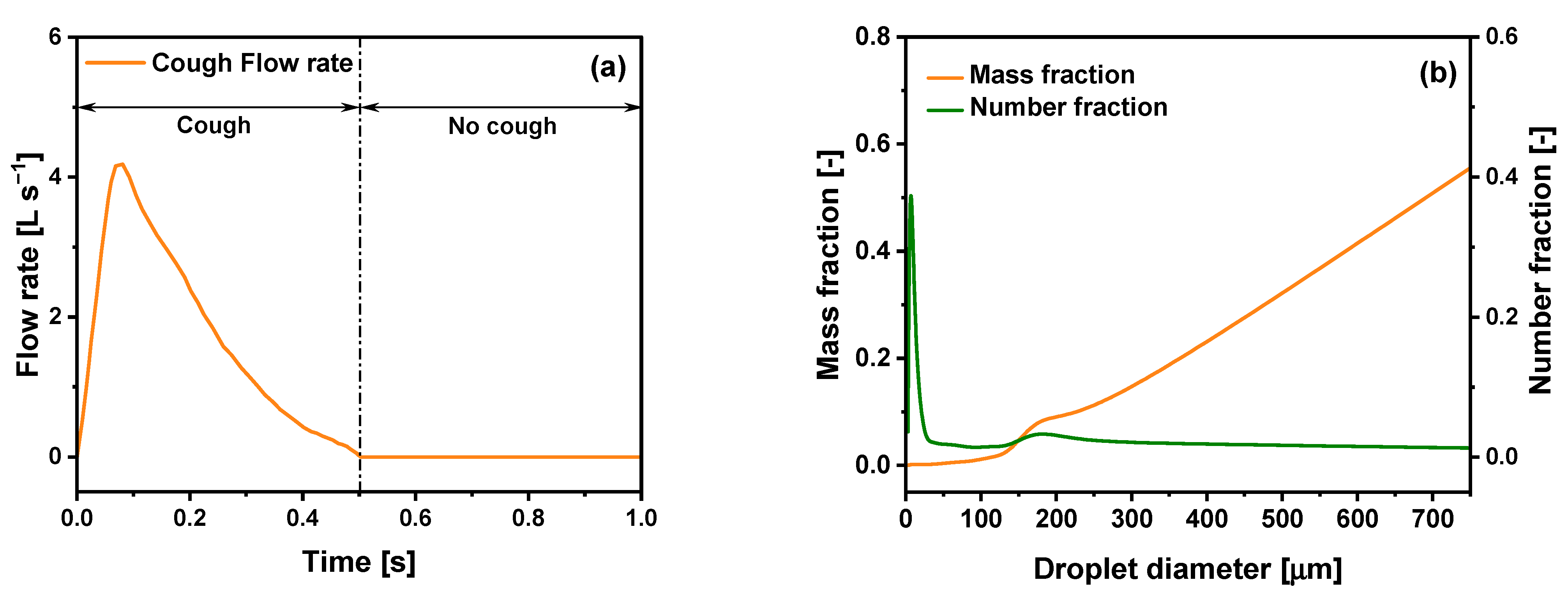
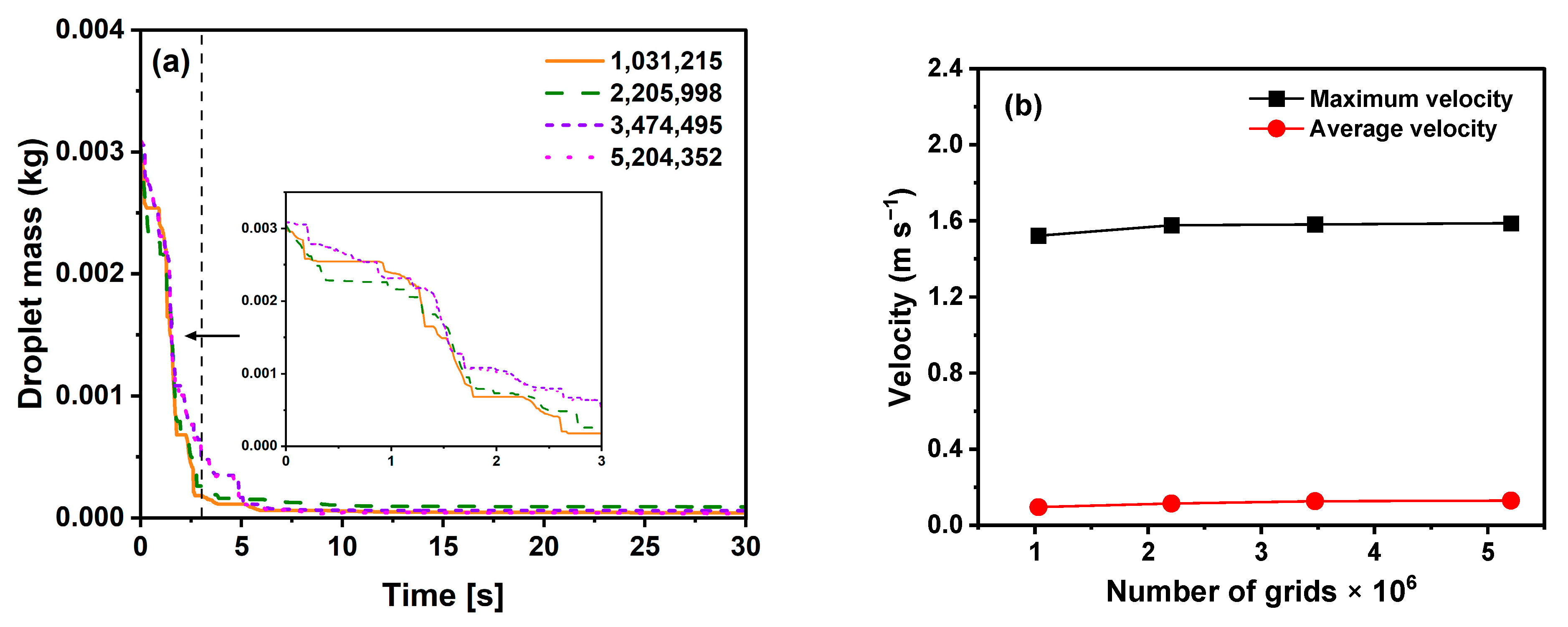
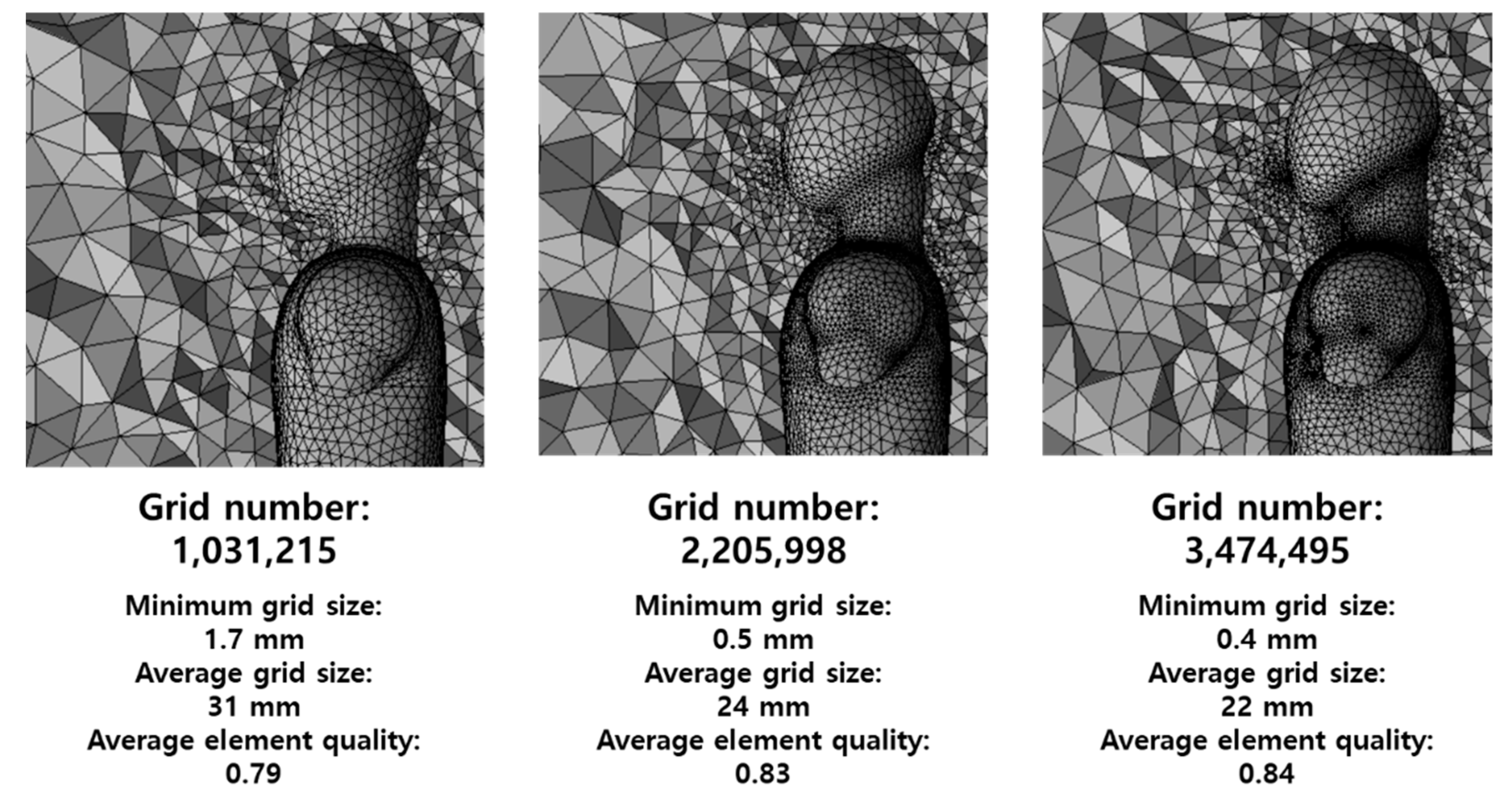

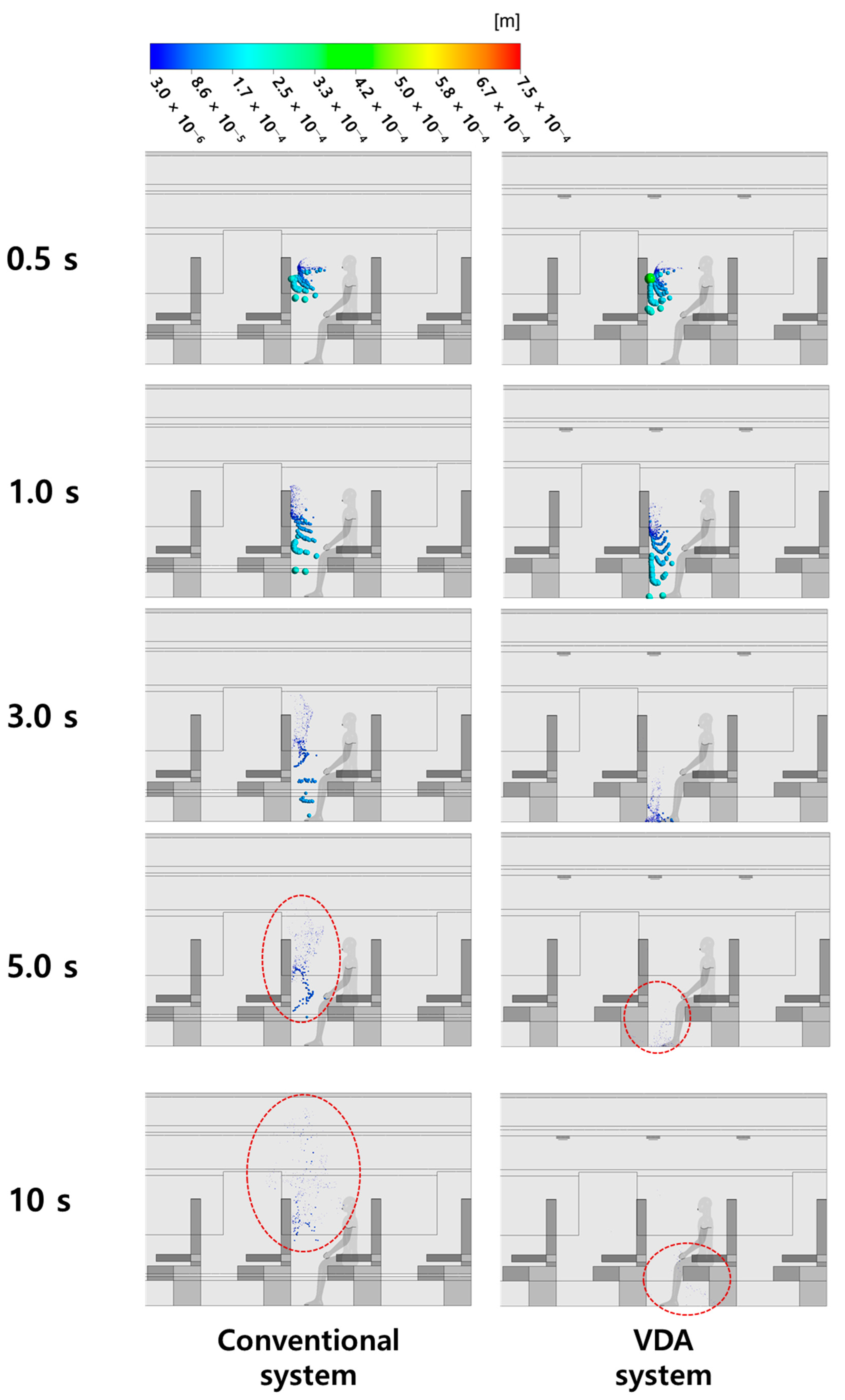

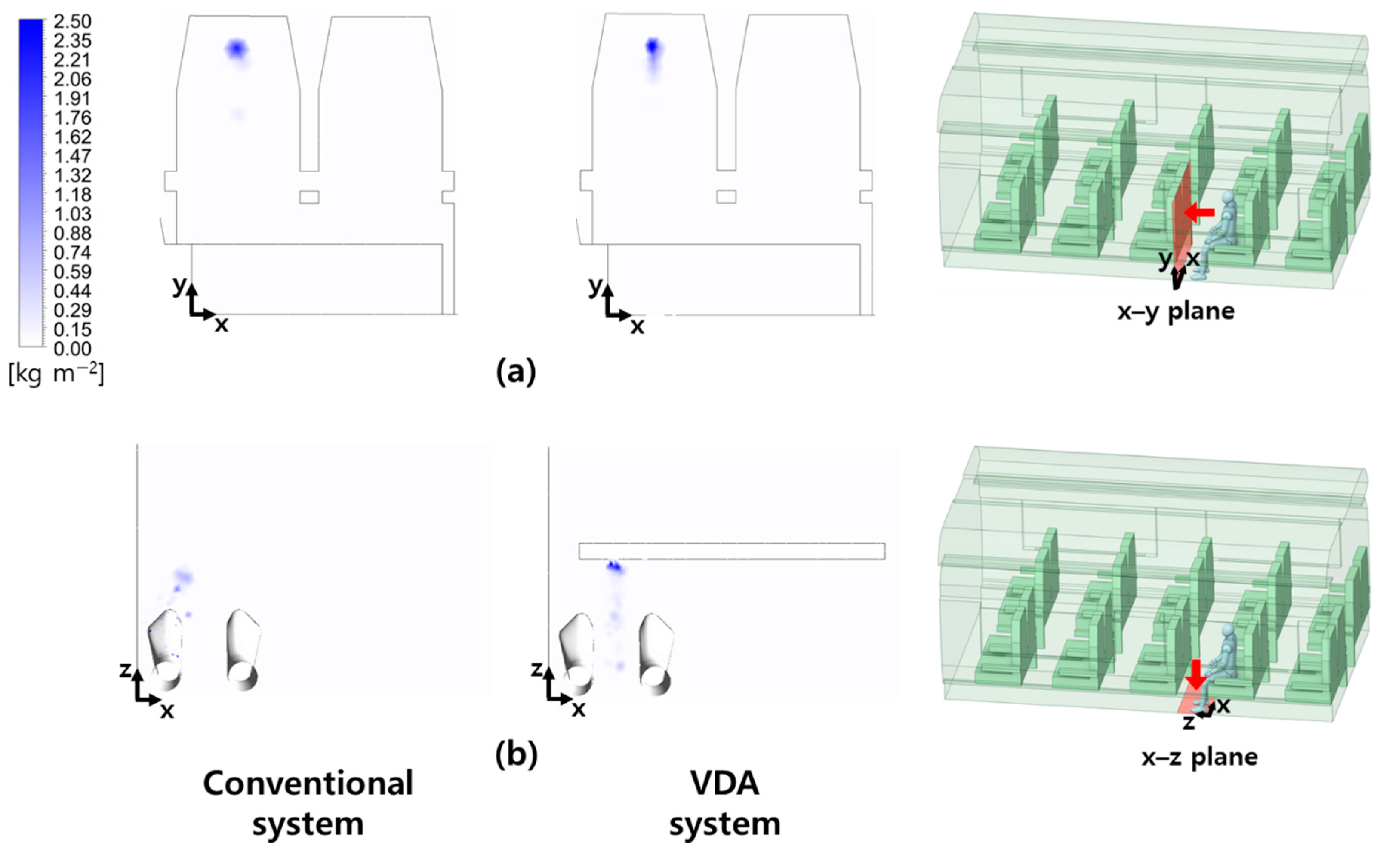

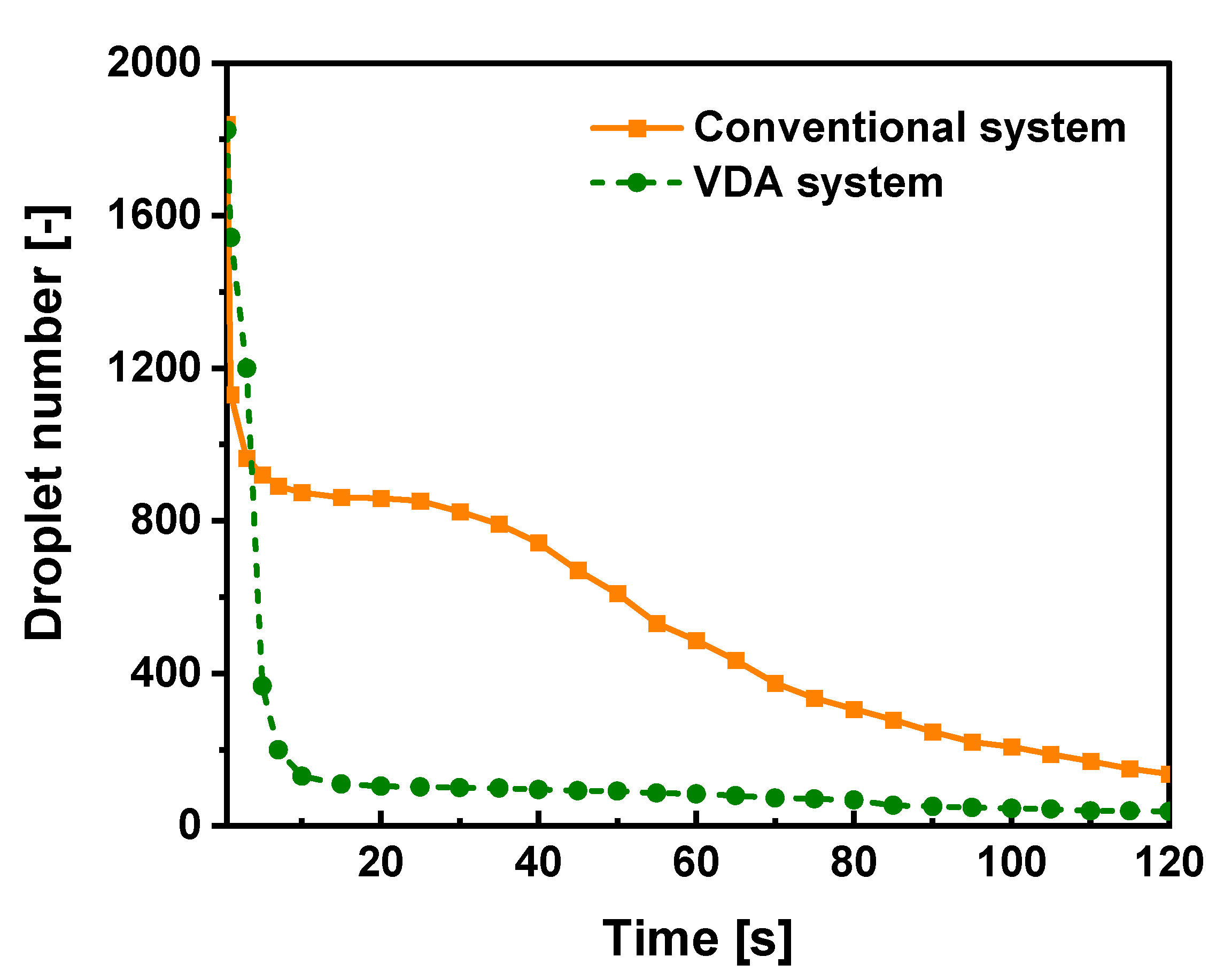
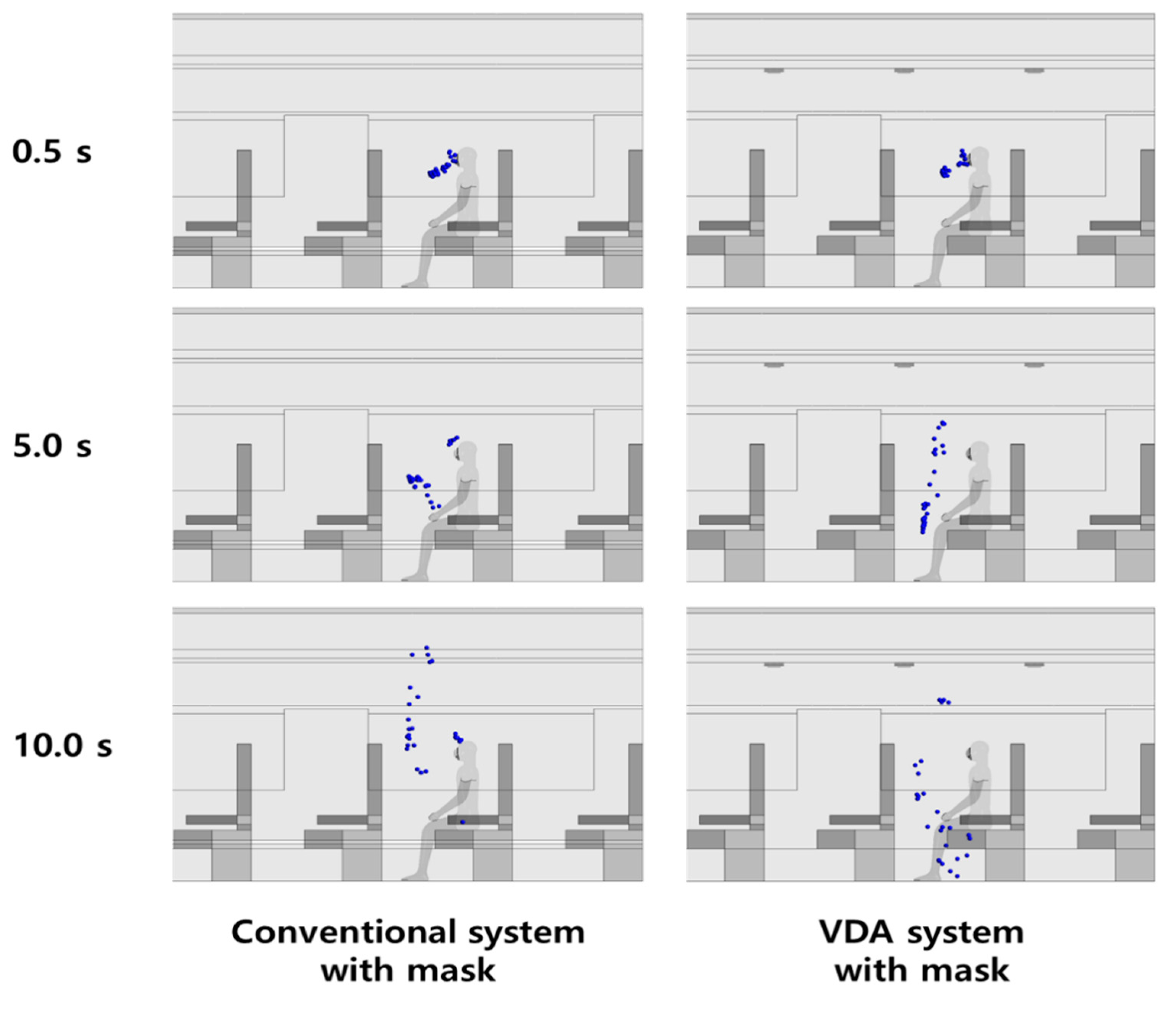
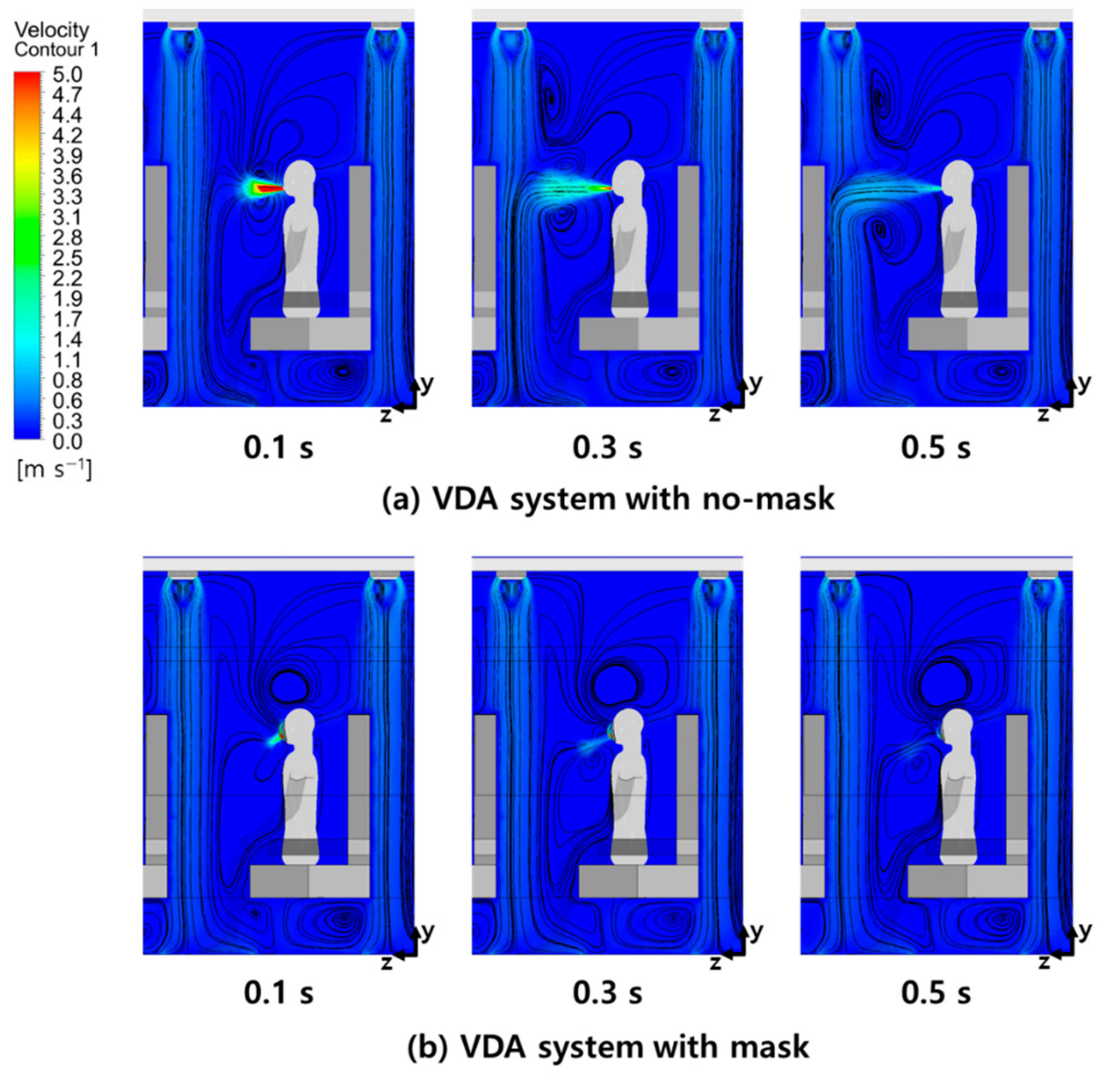



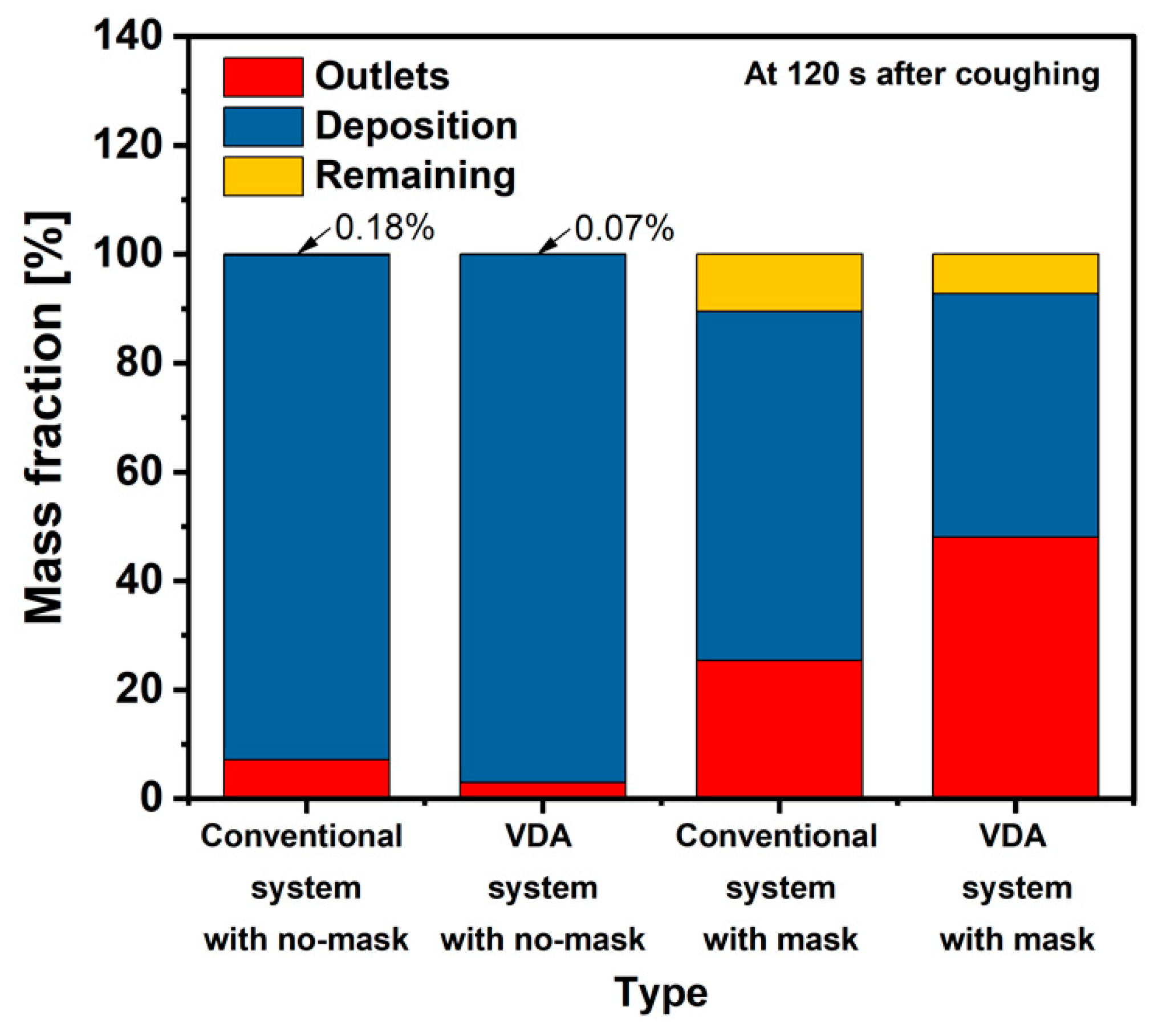
| Target | Analysis Method | Reduction of Infection Risk | Reference |
|---|---|---|---|
| Building | |||
| Restaurant | Simulation | - | [16] |
| Classroom | Simulation | - | [17] |
| Hospital | Simulation | - | [18] |
| Skilled nursing facility | Simulation | - | [19] |
| Room | Experiment and simulation | - | [22] |
| Simulation | Mask | [26] | |
| Test chamber | Experiment | Air purifier | [27] |
| Office | Simulation | Barrier | [28] |
| Simulation | Ventilation control | [29] | |
| Transportation | |||
| Cruise ship | Laboratory-confirmed case | - | [7] |
| Airplane | Laboratory-confirmed case | - | [8] |
| Simulation | - | [14] | |
| Bus | Laboratory-confirmed case | - | [9] |
| Simulation | - | [20] | |
| Simulation | - | [21] | |
| Train | Laboratory-confirmed case | - | [10] |
| Experiment | - | [12] | |
| Simulation | - | [13] | |
| Simulation | Novel airflow design | Present study |
| Parameters | Values |
|---|---|
| Cabin length | 4650 mm |
| Cabin width | 2862 mm |
| Cabin height | 2196 mm |
| Seat length | 550 mm |
| Seat width | 535 mm |
| Seat height | 1100 mm |
| Distance between seats | 930 mm |
| Height of the seated person | 1130 mm |
| Height of the person’s mouth from the floor | 1000 mm |
| Mouth area | 264 mm2 |
| Mask thickness | 1 mm |
| Mask area | 7332 mm2 |
| Parameters | Values |
|---|---|
| Conventional system | |
| Inlet area | 47,520 mm2 |
| Number of inlets | 4 |
| Outlet area | 130,200 mm2 |
| Number of outlets | 2 |
| Ventilation rate | 27.0 h−1 |
| VDA system | |
| Inlet area | 9613 mm2 |
| Number of inlets | 20 |
| Outlet area | 30,800 mm2 |
| Number of outlets | 20 |
| Ventilation rate | 27.3 h−1 |
Publisher’s Note: MDPI stays neutral with regard to jurisdictional claims in published maps and institutional affiliations. |
© 2022 by the authors. Licensee MDPI, Basel, Switzerland. This article is an open access article distributed under the terms and conditions of the Creative Commons Attribution (CC BY) license (https://creativecommons.org/licenses/by/4.0/).
Share and Cite
Yun, S.; Kim, J.-C. Numerical Evaluation of a Novel Vertical Drop Airflow System to Mitigate Droplet Transmission in Trains. Atmosphere 2022, 13, 829. https://doi.org/10.3390/atmos13050829
Yun S, Kim J-C. Numerical Evaluation of a Novel Vertical Drop Airflow System to Mitigate Droplet Transmission in Trains. Atmosphere. 2022; 13(5):829. https://doi.org/10.3390/atmos13050829
Chicago/Turabian StyleYun, Sungho, and Jae-Chul Kim. 2022. "Numerical Evaluation of a Novel Vertical Drop Airflow System to Mitigate Droplet Transmission in Trains" Atmosphere 13, no. 5: 829. https://doi.org/10.3390/atmos13050829
APA StyleYun, S., & Kim, J.-C. (2022). Numerical Evaluation of a Novel Vertical Drop Airflow System to Mitigate Droplet Transmission in Trains. Atmosphere, 13(5), 829. https://doi.org/10.3390/atmos13050829






